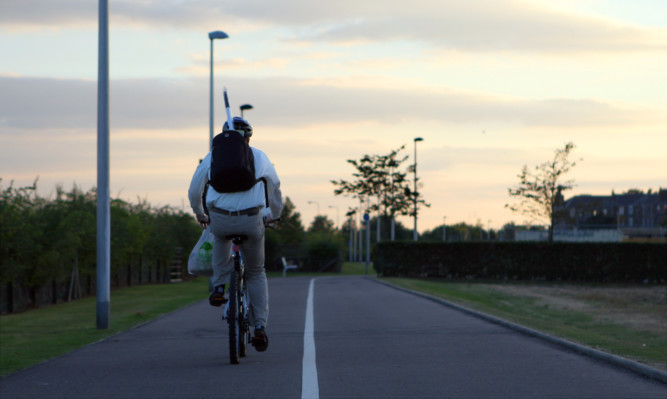Courier country is to share in a radical extension of Scotland’s walking and cycle routes.
Paths are to be extended by 500 miles over the next five years in a bid to get people more active.
Thirty new long-distance routes are to be added to the network of trails and cycleways across Scotland while some existing paths will be extended and repaired.
Among the initial priorities are an alternative to the docks section of the Dundee Green Circular.
Its general condition and the demand for cyclists to stop to show ID has long been seen as a barrier to what could be one of the city’s most popular routes.
Other priorities include the long-distance routes between Crook of Devon and Kinross, Lochearnhead to Crieff and a new Fife Pilgrim Way from Culross and North Queensferry to St Andrews.
Nationally, new routes earmarked for development include a Great Trossachs Path between Callander and Inversnaid a Hebridean Way on Harris and Lewis and the full-length “Pilgrim’s Way” across Scotland between St Andrews and Iona.
Designed by Scottish Natural Heritage, Sustrans and Scottish Canals, the plan is to develop a network on a par with the best in Europe that can be used by everyone.
The project will cost about £25 million, with funding coming from a range of public and private sources, Scottish Natural Heritage said.
Planning Secretary Alex Neil launched the scheme on the banks of the Forth and Clyde canal today.
He said: “Scotland’s extensive network of long-distance routes, national cycleways and canal towpaths is already much loved and well used.
“Encouraging more people to enjoy the natural environment is important for the environment, tourism and boosting the economy that’s why the National Long Distance Cycling and Walking Network is designated as a national development in Scotland’s National Planning Framework.
“The plan will extend the network of connected, accessible paths and tracks for visitors of all ages and abilities to walk and cycle, encouraging even more people and visitors to enjoy the outdoors and to become more active.”
Ian Ross, chairman of Scottish Natural Heritage, said: “We want to make sure that the network offers something for everyone, with rural routes offering peace and quiet, great views and the chance to get close to nature; paths between settlements to help local people commute away from traffic; high-spec surfaces in places for people in wheelchairs and cyclists, and more varied paths for walkers, mountain bikers and horse riders.
“The most important thing is to give people the chance to access and enjoy the outdoors close to where they live irrespective of their age or mobility.
“On the back of that, we hope that people will embrace healthier, more active and sustainable lifestyles.”
Discussing the plans for Dundee, a city council spokesman said: “We are considering a number of options to provide an alternative route for cyclists. The project is at a very early stage.
“We are doing all we can to encourage people to keep fit and use sustainable transport methods.
“The council and its partners have invested in a number of developments for cycling over the years in Dundee and we are currently asking cyclists to help us shape a future strategy for cycling in the city.
“The council welcomes any encouragement that can be given to people to get out and cycle in Dundee.”
For more on what is proposed for Tayside and Fife, see Friday’s Courier.
